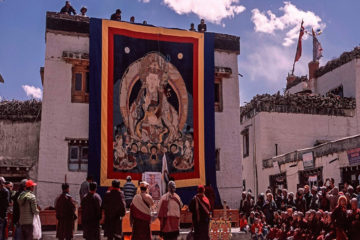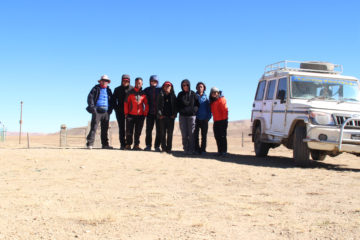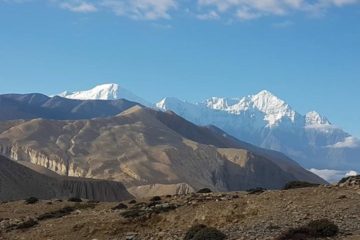Yartung Festival at Lhomanthang in details :
In the Himalayas, hidden behind the Dhaulagiri and Annapurna mountains 3,540 meters above sea level, sits the almost surreal yet breathtakingly beautiful region of Upper Mustang, Nepal. This is where the century old horse racing festival known as Yartung is held each year in the village of Lo Manthang, the 500-year-old capital. The Yartung Festival is 3 days of festivities celebrating the end of a healthy crop season and a very welcome break away from the difficult labor in the fields with an all out horse race between villagers showcasing both strength and skill.
People from all surrounding villages gather in Lo Manthang to take part. Each day they line their brightly decorated horses up, one after another, outside the square of the royal city by noon. The celebration won’t kick off until you hear the beating of drums and the humming of voices marching down the street as the village elders lead the community in song. The race begins in a cloud of dust as the horses and riders are off.
The festival lasts for 3 days and each day marks a new way of celebration. Day one is the King’s day, reserved only for the men. Day two is the Queen’s day where the women will take part in singing and dancing alongside the men. Day three is for the monks. Although Lo Manthang is geographically located in Nepal, the Tibetan lifestyle is prevalent throughout. The monks from the village monasteries gather in traditional dress to take part in the celebration, eating and playing card games.
Every day begins with a sign of friendship and good faith by members of the different villages offering scarves and small gifts to other community members. After the initial horse race into the open fields where tents have been set up they allow their horses to be released into the field while they celebrate by singing and dancing to the traditional beats and enjoying the local drink, Chong. As the afternoon of lively celebration ends the horses are saddled once more and the men are off on a race back to the village. It’s here, in the evening light, where spectators gather on tops of buildings, standing elbow to elbow to watch riders aged 16 to 65 race back and forth down a small road until the last bit of sun has slipped away. It’s a celebration of camaraderie and competition you can feel as well as see.
June 17 : Day 01: Arrival in kathmandu
It is a panoramic thrill flying into Kathmandu on a clear day. The views of snow-capped mountain peaks sprawling down below you are almost ecstatic, beginning a whole chain of memorable experiences that stay with you for a long, long time. A representative and driver from our office will meet you at the airport and escort you to your hotel. The representative will help you check into your designated hotel. At the hotel, you will be briefed about your daily activities
June 18 : Day 02: Sightseeing of Kathmandu Valley
Kathmandu is the historical and cultural heart of Nepal and has been a popular destination for tourists ever since Nepal opened its doors to visitors. The city presents a wonderful mix of Hinduism, Tibetan Buddhism and Western influence in the Valley. Patan and Bhaktapur, its two major neighboring cities bear immense historical, cultural and religious significances. There will be a half day guided tour to the famous & biggest Hindu shrine of Pashupatinath, the largest Buddhist stupa in Nepal Boudhanath, the 15th century Palace of 55 windows and Swoyambhunath.
June 19 : Day 03: Fly to Pokhara
We take the short but scenic 30 minute flight to Pokhara, enjoying the views of Ganesh, Manaslu and the Annapurnas along the way. We stay overnight in Pokhara.
June 20 : Day 04: Fly to Jomsom & Trek to Kagbeni [2780m]
We take the spectacular early morning flight to Jomsom (famous for its apples) where we will be met at the tiny airstrip by our trek crew. After some initial preparation of loads, we begin our trek to the pretty village of Kagbeni. Just out of Jomsom we cross a small suspension bridge and then walk along the riverbank of the Kali Gandaki. The trail is flat and quite barren, with craggy rocks and sand littering the trail. This makes it very easy going. We will get magnificent views of huge peaks such as Dhaulagiri, Tukuche and Nilgiri, whilst to the south can be seen the entire Annapurna massif. Kagbeni with its narrow alleyways and tunnels, irrigation canals, fields of wheat and barley and a large red Gompa, give us a preview of scenes that we would come across in Upper Mustang. At the north end of the village is the police check-post. Here we will complete our paperwork before entering this long forbidden region of Nepal.
June 21: Day 05: Trek to Chhuksang [2920m]
It is possible to trek right up the river valley, but we use a combination of the high trail and the riverbank pathways. The trail then widens significantly revealing an endless stretch of sand but the path is kept interesting by the passing of mule trains bearing goods from Mustang and Tibet. On the west bank of the river are some caves and Gompa Kang. Unlike most monasteries in Upper Mustang which are of the Sakyapa sect, Gompa Kang is of the Nyingmapa sect. We stop for lunch at the village of Tangbe, where we come across the first black, white and red Chortens that typify Upper Mustang. The little town is a labyrinth of narrow alleys among white washed houses, fields of buck wheat and barley and apple orchards. Nilgiri Peak continues to dominate the southern skyline. Chhuksang village is only about 2hrs walk beyond Tangbe at the confluence of the Narshing Khola and the Kali Gandaki. There are three separate parts to this village and some ruined castle walls on the surrounding cliffs. Across the river from Chhuksang are some spectacular red eroded cliffs above the mouths of some inaccessible caves.
June 22: Day 06: Trek to Samar [3290m]
There is a distinct change here, not only in the topography, but also in the culture, lifestyle and people, and the settlements become more scattered, smaller and more basic. The people of Lo or Mustang practice agriculture. But due to lack of rain and fertile soil, cultivation is limited to sheltered plots of land. This spots the brown landscape with patches of green. Continuing north, we reach the river. A steel bridge spans the river just in front of a tunnel and north from here the Kali Gandaki becomes impassable by foot. The trek now leaves the valley and climbs steeply up a rocky gully to the village of Chele. Watch out for the ferocious Tibetan mastiffs here, which are chained to many of the houses. From Chele you climb a steep spur and then continue ascending along the side of a spectacular steep canyon to a pass. Beyond the pass we descend on a pleasant trail to Samar, situated in a grove of poplar trees. This is a major place to stop for horse and mule caravans.
June 23 :Day 07: Trek to Geling [3440m]
We climb above Samar to a ridge and then descend into a large gorge past a Chorten before entering another valley filled with juniper trees. We then cross a stream and after climbing to a pass, we descend along a ridge to Shyangmochen, a tiny settlement with a few tea shops. Nearby is Rangbyung, a cave containing stalagmites which have formed in the shape of Chorten and one of the holiest places in Mustang. The trail climbs gently from Shyangmochen and we enter another huge valley before descending to Geling, with its extensive fields of barley. Like in all settlements of Mustang, the white and ochre-painted houses in Geling are constructed using mud and stones. The roofs are made of twigs, straw and a mixture of mud and pebbles.
June 24 : Day 08: Trek to Ghami [3460m]
From Geling, the trail climbs gently through fields, up the center of the valley, passing above the settlement of Tama Gun and an imposing Chorten. We then begin a taxing climb across the head of the valley to the Nyi La [3840m]. The descent from the pass is quite gentle and about half an hour further on we come to a trail junction; the right trail is the direct route to Charang, the left trail leads to Ghami. Ghami is a large white-washed village sheltered by overhanging cliffs.
June 25 : Day 09: Trek to Charang [3490m]
Today’s walk is through perhaps the driest part of Mustang, and much of our energy will be spent negotiating the loose, dry soil. However, the magnificent views of the countryside, from the gentle contours of the north to the rugged mountains in the east and west, more than compensates for the hard climb. Finally, we come to Charang, a large spread-out village at the top of the Charang Chu canyon. At the eastern end of the village are a huge dzong [fortress] and a red gompa which houses an excellent collection of statues and thangkas.
June 26 :Day 10: Trek to Lo Manthang [3730m]
We will spend part of the morning exploring the interesting village of Charang and its large monastery, before setting out for Lo Manthang. We climb gently above the valley to a large isolated Chorten that marks the boundary between Charang and Lo Manthang. The trail then broadens and eventually we get our first view of the walled city of Lo Manthang. The city has only one entrance so we circumambulate the wall to the gate on the north-east corner.
June 27-28-29 : Day 11-12-13 : Main YARTUNG FESTIVAL .
June 30 : Day 14: Trek to Jomsom [2710m]
It’s a long and sad final day, passing back through Kagbeni to Jomsom where we end our trek. It’s now time for us to take a nice hot shower. In the evening, we celebrate with the Sherpas and porters, whom we have come to know so well over the last 2 weeks.
August 01 : Day 15: Fly to Kathmandu via Pokhara
We take a spectacular early morning flight along the Kali Gandaki gorge to Pokhara and catch a connecting flight back to Kathmandu.
August 02 : Day 17: Depart Kathmandu
Our Nepalese support team will take you to the airport for your flight home. On the other hand, if you prefer to stay longer, you can go for short tours such as game drive at National parks, rafting, Tibet tours, mountain biking etc).
Cost included
Pick and drop.
Twin Sharing accommodation in Kathmandu and Pokhara with breakfast.
Kathmandu-Pokhara-Kathmandu by tourist Bus.
Pokhara-Jomsom-Pokhara by domestic flight.
Annapurna conservation area entrance fees
Trekking permit
Guide and necessary staffs.
Three Meals during your program.
Accommodation in Local Lodge during the program.
Cost Excluded
Your visa for Nepal.
International flight tickets.
Food in Kathmandu and Pokhara.
Your personal insurance.
Any type of donations
Tips for your staffs.
Any unseen personal expenses other than above mentioned.
Medical evacuation such as helicopter, porter or any other means of transportations in case of emergency.





Tour Reviews
There are no reviews yet.
Leave a Review